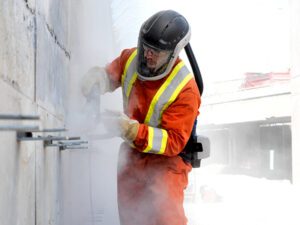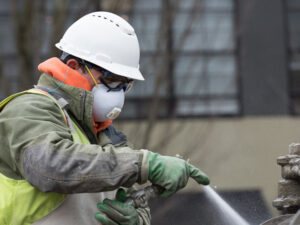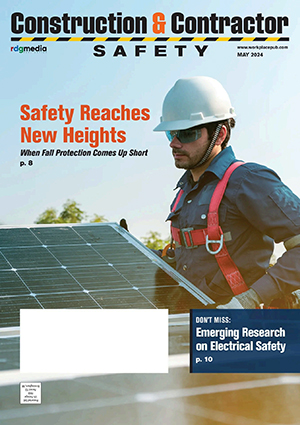Working Safely Around Silica
By Rick Pedley, Contributor
Drilling, crushing, sanding, and grinding can all leave construction workers exposed to silica dust. These tiny particles can easily spread through the air and enter a person’s mouth or nose. Breathing in silica can lead to silicosis – an incurable and often deadly disease of the lungs – as well as lung cancer, chronic obstructive pulmonary disease, and kidney disease. These conditions can often form even years after exposure to silica dust.
Measure Exposure Levels
 Construction crews need to take precautions to protect themselves from health and safety hazards caused by silica dust. According to OSHA Standard 29 CFR 1926.1153, employers must limit worker exposure to respirable crystalline silica. To comply with this standard, companies can use a control method to prevent these particles from spreading through the air. They can also measure the amount of silica dust in the atmosphere compared to the permissible exposure limit (PEL) to determine if additional safety measures are required.
Construction crews need to take precautions to protect themselves from health and safety hazards caused by silica dust. According to OSHA Standard 29 CFR 1926.1153, employers must limit worker exposure to respirable crystalline silica. To comply with this standard, companies can use a control method to prevent these particles from spreading through the air. They can also measure the amount of silica dust in the atmosphere compared to the permissible exposure limit (PEL) to determine if additional safety measures are required.
Companies engaged in activities that are known to spread silica dust at or above the action level of 25 μg/m3 (micrograms of silica per cubic meter of air), averaged over an 8-hour day, must measure the dust levels. Additional protection methods are required if exposure exceeds the 50 μg/m3 PEL, averaged over an 8-hour day.
Protect Against Inhalation
 A respirator can offer the best protection against silica dust. Workers should have access to personal protective equipment with an assigned protection factor (APF) of at least 10. It should have a NIOSH rating of N95 or higher, such as P100. N95 filters will capture 95% of dust particles, including those from silica. The mask or respirator must also be NIOSH-certified and cover the person’s nose and mouth without any gaps. Ensuring the mask or respirator fits securely onto the worker’s face is crucial. The company should provide a range of styles and sizes to give their workers more options. Most items come with an adjustable strap that lets the person tighten the mask over their face. If the person has facial hair, they may need a full-face mask or hood.
A respirator can offer the best protection against silica dust. Workers should have access to personal protective equipment with an assigned protection factor (APF) of at least 10. It should have a NIOSH rating of N95 or higher, such as P100. N95 filters will capture 95% of dust particles, including those from silica. The mask or respirator must also be NIOSH-certified and cover the person’s nose and mouth without any gaps. Ensuring the mask or respirator fits securely onto the worker’s face is crucial. The company should provide a range of styles and sizes to give their workers more options. Most items come with an adjustable strap that lets the person tighten the mask over their face. If the person has facial hair, they may need a full-face mask or hood.
Working indoors can increase the risk of silica exposure due to a lack of ventilation. Individuals using drills, saws, and other construction tools should try to work outside whenever possible to reduce their risk. If indoor operation is necessary, various control methods can limit the amount of silica dust in the air.
For example, water can be added to the surface material to minimize the dust created. These particles will lump together instead of being released into the atmosphere. Some tools have built-in irrigation systems that automatically send water through the blade. Other options include using a vacuum to suck up the particles or installing an air-tight barrier to stop particles from spreading around the workplace. If these control methods aren’t enough to keep workers under the PEL, they are required to wear a respirator for additional protection.
Silica dust is a common hazard in the construction industry. Some 2 million construction workers are exposed to respirable crystalline silica in over 600,000 workplaces. Crews need to keep these tips in mind to protect themselves from harm.
Rick Pedley is President and CEO, PK Safety (pksafety.com).



